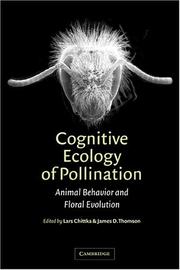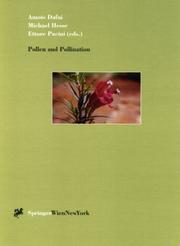| Listing 1 - 10 of 17 | << page >> |
Sort by
|
Book
ISBN: 9781624175015 1624175015 9781612096346 1612096344 Year: 2012 Publisher: New York Nova Science Publishers
Abstract | Keywords | Export | Availability | Bookmark
 Loading...
Loading...Choose an application
- Reference Manager
- EndNote
- RefWorks (Direct export to RefWorks)
Pollination. --- Pollinization --- Fertilization of plants --- Flowers --- Phanerogams --- Plants --- Pollen --- Self-incompatibility
Book
ISBN: 9067543616 Year: 1994 Publisher: Wageningen : Agricultural University,
Abstract | Keywords | Export | Availability | Bookmark
 Loading...
Loading...Choose an application
- Reference Manager
- EndNote
- RefWorks (Direct export to RefWorks)
Apocynaceae --- Pollinisation --- Pollination --- Pollinization --- Fertilization of plants --- Flowers --- Phanerogams --- Plants --- Pollen --- Dogbane family (Plants) --- Landolphiinae --- Gentianales --- Self-incompatibility
Book
ISBN: 0080213383 9780080213385 Year: 1979 Publisher: Oxford Pergamon
Abstract | Keywords | Export | Availability | Bookmark
 Loading...
Loading...Choose an application
- Reference Manager
- EndNote
- RefWorks (Direct export to RefWorks)
Pollination --- Plant ecology --- 581.1 --- Pollinization --- Fertilization of plants --- Flowers --- Phanerogams --- Plants --- Pollen --- Botany --- Ecology --- Plant physiology --- Self-incompatibility --- 581.1 Plant physiology --- Phytoecology --- Vegetation ecology --- Floristic ecology
Book
ISBN: 0125839820 0125839804 0323154514 1299365779 9780125839822 9780125839808 Year: 1974 Publisher: Orlando Institute of internal auditors
Abstract | Keywords | Export | Availability | Bookmark
 Loading...
Loading...Choose an application
- Reference Manager
- EndNote
- RefWorks (Direct export to RefWorks)
581.162.3 --- #WPLT:syst --- 581.162.3 Pollination --- Pollination --- out of print --- Plant physiology. Plant biophysics --- Pollinization --- Fertilization of plants --- Flowers --- Phanerogams --- Plants --- Pollen --- Self-incompatibility

ISBN: 1107120543 1280421371 9786610421374 0511174691 0511040970 0511154690 051132524X 0511542267 0511046154 9780511040979 9780511542268 9780511046155 9780511154690 9781280421372 0521781957 9780521781954 9780521781954 9781107120549 6610421374 9780511174698 9780521018401 Year: 2001 Publisher: Cambridge Cambridge University Press
Abstract | Keywords | Export | Availability | Bookmark
 Loading...
Loading...Choose an application
- Reference Manager
- EndNote
- RefWorks (Direct export to RefWorks)
Important breakthroughs have recently been made in our understanding of the cognitive and sensory abilities of pollinators: how pollinators perceive, memorise and react to floral signals and rewards; how they work flowers, move among inflorescences and transport pollen. These new findings have obvious implications for the evolution of floral display and diversity, but most existing publications are scattered across a wide range of journals in very different research traditions. This book brings together for the first time outstanding scholars from many different fields of pollination biology, integrating the work of neuroethologists and evolutionary ecologists to present a multi-disciplinary approach. Aimed at graduates and researchers of behavioural and pollination ecology, plant evolutionary biology and neuroethology, it will also be a useful source of information for anyone interested in a modern view of cognitive and sensory ecology, pollination and floral evolution.
Pollinators --- Pollination. --- Pollinization --- Fertilization of plants --- Flowers --- Phanerogams --- Plants --- Pollen --- Pollenizers --- Pollinating organisms --- Pollinating species --- Pollinator organisms --- Pollinator species --- Pollinizers --- Biology --- Ecophysiology. --- Self-incompatibility
Book
ISBN: 9251036594 Year: 1995 Volume: 118 Publisher: Rome FAO
Abstract | Keywords | Export | Availability | Bookmark
 Loading...
Loading...Choose an application
- Reference Manager
- EndNote
- RefWorks (Direct export to RefWorks)
Plants, Cultivated --- Pollination --- Pollination by insects --- -Pollination --- -Pollination by insects --- -Insect pollination --- Fertilization of plants by insects --- Pollinization --- Fertilization of plants --- Flowers --- Phanerogams --- Plants --- Pollen --- Cultivated plants --- Agriculture --- Domestication --- Plant introduction --- Plants, Useful --- Self-incompatibility --- -Plants, Cultivated --- Insect pollination

ISBN: 3211835148 3709172489 3709163064 Year: 2000 Publisher: Wien Springer
Abstract | Keywords | Export | Availability | Bookmark
 Loading...
Loading...Choose an application
- Reference Manager
- EndNote
- RefWorks (Direct export to RefWorks)
Pollen studies make important contributions nature, into three main themes: pollen struc to our knowledge in many interdisciplinary ture and constituents, pollen evolutionary arenas. Pollen identification is widely used in ecology and the pollen-pollinator interface. reconstruction of, e.g., vegetation, the climate Several papers overlap somewhat or are of the past, and plant biodiversity. Studies perhaps even somewhat contradictory and concerning pollen structure, size and form are reflect the author's own ideas and experience. key issues in basic sciences, as, e.g., plant Some could be understood more deeply by taxonomy and evolution, but are also of consulting other closely related articles. The importance in applied fields as, e.g., plant reader is strongly referred to the respective breeding. In pollination studies pollen is literature list of each article. generally used specifically to identify food ofanther ripening and pollen The last steps development (Pacini) and the mature pollen sources of visitors and to reconstruct their foraging routes. Fewer have been devoted to wall structure (Hesse) are key factors to pollen collection mechanisms and to the struc understand pollen dispersal mechanisms in ture and content of pollen in relation to its biotic pollination (Stroo) as well as abiotic pollination (Ackerman). Pollen size, shape, function.
581.331.2 --- 581.162.3 --- Pollen grains --- Pollination --- REP Reproductive Biology --- pollen morphology --- pollination --- reproductive biology --- 581.162.3 Pollination --- 581.331.2 Pollen grains --- Plant science. --- Botany. --- Plant Sciences. --- Botanical science --- Phytobiology --- Phytography --- Phytology --- Plant biology --- Plant science --- Biology --- Natural history --- Plants --- Floristic botany --- Pollen --- Pollinization --- Fertilization of plants --- Flowers --- Phanerogams --- Grains, Pollen --- Pollinaria --- Anther --- Palynology --- Self-incompatibility
Book
ISBN: 1461405912 9786613353191 1283353199 1461405920 Year: 2012 Publisher: New York : Springer,
Abstract | Keywords | Export | Availability | Bookmark
 Loading...
Loading...Choose an application
- Reference Manager
- EndNote
- RefWorks (Direct export to RefWorks)
Recent studies have revealed remarkable complexity and diversity in orchid-pollinator relationships. These studies comprise a vast literature currently scattered in numerous, often obscure, journals and books. The Pollination Biology of North American Orchids brings together, for the first time, a comprehensive treatment of this information for all native and introduced North American orchids found north of Mexico and Florida. It provides detailed information on genetic compatibility, breeding systems, pollinators, pollination mechanisms, fruiting success, and limiting factors for each species. Distribution, habitat, and floral morphology are also summarized. In addition, detailed line drawings emphasize orchid reproductive organs and their adaptation to known pollinators. This, the first of two volumes, furnishes a brief introduction to the general morphology of the orchid flower and the terminology used to describe orchid breeding systems and reproductive strategies. It treats the lady’s-slippers of genus Cypripedium, subfamily Cypripedioideae, and nine genera of the subfamily Orchidoideae, including the diverse rein orchids of genus Platanthera. The Pollination Biology of North American Orchids will be of interest to both regional and international audiences including: Researchers and students in this field of study who are currently required to search through the scattered literature to obtain the information gathered here. Researchers and students in related fields with an interest in the co-evolution of plants and insects. Conservation specialists who need to understand both the details of orchid reproduction and the identity of primary pollinators in order to properly manage the land for both. Orchid breeders who require accurate and current information on orchid breeding systems. General readers with an interest in orchid biology. Charles Argue, Ph.D., is a plant biologist at the University of Minnesota specializing in the study of pollen grains. His articles have appeared in numerous journals including the American Journal of Botany, International Journal of Plant Sciences (formerly Botanical Gazette), Botany (formerly Canadian Journal of Botany), Grana, Pollen et Spores, North American Native Orchid Journal, The Native Orchid Conference Journal, Fremontia, and as chapters in a number of books.
Orchids -- Pollination -- North America. --- Pollinators -- North America. --- Botany --- Earth & Environmental Sciences --- Botany - General --- Plant Ecology --- Pollination. --- Orchids --- Orchidaceae --- Pollinization --- Life sciences. --- Plant science. --- Botany. --- Plant anatomy. --- Plant development. --- Plant physiology. --- Plant breeding. --- Life Sciences. --- Plant Sciences. --- Plant Anatomy/Development. --- Plant Breeding/Biotechnology. --- Plant Physiology. --- Orchidales --- Fertilization of plants --- Flowers --- Phanerogams --- Plants --- Pollen --- Self-incompatibility
Book
ISBN: 0891180346 9780891180340 Year: 1982 Publisher: Madison (Wis.): American society of agronomy
Abstract | Keywords | Export | Availability | Bookmark
 Loading...
Loading...Choose an application
- Reference Manager
- EndNote
- RefWorks (Direct export to RefWorks)
Hybridization, Vegetable --- Plant breeding --- Pollination --- Pollinization --- Fertilization of plants --- Flowers --- Phanerogams --- Plants --- Pollen --- Crops --- Agriculture --- Breeding --- Hybridization --- Self-incompatibility --- Plant hybridization --- Plant hybridization. --- Plant and Crop Sciences. Plant Breeding and Genetics --- Plant Breeding and Genetics (General) --- Plant Breeding and Genetics (General). --- Plant breeding. --- Pollination.
Book
ISBN: 0199632987 0199632995 9780199632985 9780199632992 Year: 1992 Volume: 110 Publisher: Oxford [England] New York IRL Press at Oxford University Press
Abstract | Keywords | Export | Availability | Bookmark
 Loading...
Loading...Choose an application
- Reference Manager
- EndNote
- RefWorks (Direct export to RefWorks)
Pollination is one of the most important processes in determining the diversity of plants, particularly in terms of their colors, fruit yield, and most other genetic factors. The mechanisms of pollination are very different depending on the type of plant, and they often rely on the activities of insects. Because of this diversity, pollination is greatly affected by the ecology of the environment in which the plant is growing. Hence detailed knowledge of the pollination process and how this can be affected by ecological factors is crucial to a wide range of people working with plants, from researchers to farmers. This book describes in detail the techniques used to study pollination mechanisms, thus providing the reader with all the necessary key information needed to carry out the experimental protocols provided. Researchers in plant science, zoology, and ecology will find this text to be a valuable reference. It provides a guide to the modern procedures and techniques used in the study of pollination ecology. The papers cover the recording of floral phenology, pollen histochemistry, measurement of pollination efficiency, and the investigation of breeding systems. Graphs, tables, and references supplement each chapter. Four appendices provide information on the trapping and marking of foragers, a list of reagents and solutions, a list for further reading, and suppliers of equipment.
Botany --- Pollination --- Botanique --- Pollinisation --- Ecology --- Ecologie --- Plant ecology --- Plant ecology. --- Pollination. --- Plant and Crop Sciences. Apiculture --- Bee Plant Relations --- ecology --- pollination --- reproductive biology --- Bee Plant Relations. --- Environmental Science --- Bionomics --- Ecologies --- Environmental Sciences --- Science, Environmental --- Sciences, Environmental --- Environmental Psychology --- Conservation of Natural Resources --- Environmental Health --- Ecosystem --- Botanies --- Plants --- Pollinization --- Fertilization of plants --- Flowers --- Phanerogams --- Pollen --- Self-incompatibility --- Reproduction --- Phytoecology --- Vegetation ecology --- Floristic ecology --- POLLINATION --- MANUALS --- METHODS --- FLOWERS --- FLOWERING --- PHENOLOGY --- BREEDING --- POLLEN --- STIGMA --- POLLINATORS --- ABIOTIC POLLINATION --- ECOLOGY --- MORPHOLOGY --- MECHANISMS --- BIOLOGY --- INTERACTIONS
| Listing 1 - 10 of 17 | << page >> |
Sort by
|

 Search
Search Feedback
Feedback About UniCat
About UniCat  Help
Help News
News